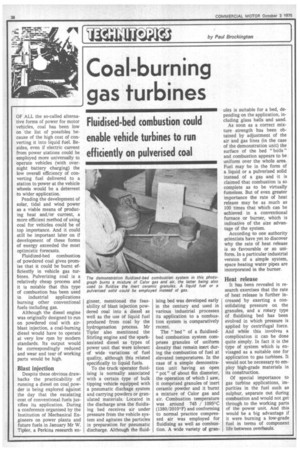Coal-burning gas turbines
Page 40

If you've noticed an error in this article please click here to report it so we can fix it.
Fluidised-bed combustion could enable vehicle turbines to run efficiently on pulverised coal
OF ALL the so-called alternative forms of power for motor vehicles, coal has been low on the list of possibles because of the high cost of converting it into 'liquid fuel. Besides, even if electric current from power 'stations could be employed more universally to operate vehicles (with overnight battery charging) the low overall efficiency of converting fuel delivered to a station to power at the vehicle Wheels would be a deterrent to wider 'application.
Pending the development of solar, tidal and Wind power as a viable means of producing heat and/or current, a more efficient method of using coal for vehicles could be of top importance. And it could still be important later on if development of these forms of energy exceeded the most optimistic forecasts.
Fluidized-bed combustion of powdered coal gives promise that it could be burnt efficiently in vehicle gas turbines. Pulverizing coal is a relatively cheap process and it is notable that this type of combustion has been used in industrial applications burning other conventional fuels including gas.
Although the diesel engine was originally designed to run on powdered coal with airblast injection, a coal-burning diesel would have to operate at very low rpm by modern standards. Its output would be correspondingly reduced and wear and tear of working parts would be high.
Blast injection
Despite these obvious drawbacks the practicability of running a diesel on coakpowder is being explored 'against the day that the escalating cast of conventional, fuels justifies its application. During a conference organised by the Institution of Mechanical Engineers on power plants and future fuels in January Mr W. Tipsier, a Perkins research en gineer, mentioned the feasability of blast injection powdered coal into a diesel as well as the use of liquid fuel produced from coal by the hydrogenation process. Mr Tipler also mentioned the Stirling engine and the sparkassisted diesel as types of power unit that were tolerant of wide variations of fuel quality, although this related specifically to liquid fuels.
To the truck operator fluidising is normally associated with a certain type of bulk tipping vehicle equipped with a pneumatic dischage system and carrying powders or granulated materials. Located in the discharge area the fluidising bed receives air under pressure from the vehicle system and agitates the particles in preparation for pneumatic discharge. Although the fluid ising bed was developed early in the century and used in various industrial processes its 'application to a combustion system is comparatively recent.
The "bed" of a fluidisedbed combustion system comprises granules of uniform density that remain inert during the combustion of fuel at elevated temperatures. In the case of a simple demonstration unit having an open " pot " of about Sin diameter, the operation of which I saw, it comprised granules of inert ceramic powder and it burnt a mixture of Calor gas and air. Combustion temperature was around 745 / 1095°C (1380/2010°F) and conforming to normal practice compressed air was employed for fluidising as well as combustion. A wide variety of gran ules is suitable for a bed, depending on the application, including glass balls and 'sand.
As soon as a correct mixture strength has been obtained by adjustment of the air and gas lines (in the case of the demonstration unit) the surface of the bed " boils " and combustion appears to be uniform over the whole area. Fuel may be in the form of a liquid or a pulverised solid instead 'of a gas and it is claimed that combustion is so complete as to be virtually fumeless. But of even greater importance the rate of heat release may be as much as 100 times that which can be achieved in a conventional furnace or burner, which is indicative of the size advantage 'of the system.
According to one authority scientists have yet to discover why the rate of heat release is so favourable or so uniform. In a particular industrial version of a simple system, space heating water pipes are incorporated in the burner.
Heat release
It has been revealed in research exercises that the rate of heat release is further increased by exerting a consolidating pressure on the granules, and a rotary type of fluidising bed has been evolved in which pressure is applied by centrifugal force. And while this involves a complication it can be done quite simply. In fact it is the type of system which is envisaged as a suitable one for application to gas turbines. It would not be necessary to employ high-grade materials in its construction.
Of 'special importance to gas turbine applications, impurities in the fuel such as sulphur, separate out during combustion and would not get through to the working parts of the power unit. And this would be a 'big advantage if it were burning a low-grade fuel in terms of component life 'between overhauls.




































































































